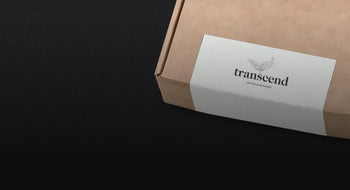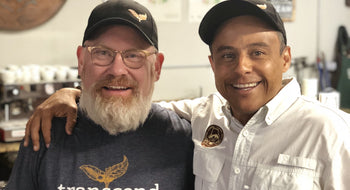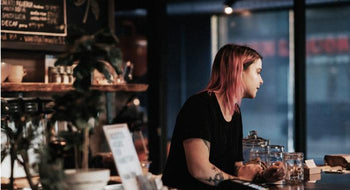Improve your tasting skills

We often say that tasting coffee is difficult, much harder than tasting wine. While this is indeed the case, it is not to say that you can’t improve your coffee tasting skills. Drinking coffee, especially great quality coffee, should always be more than just a caffeine fix.
When you look at the science in and around flavours in food and beverage, we are told that all of us are roughly equal when it comes to our ability to perceive flavour and aroma. However, where things are not equal is in our abilities to recollect flavours and aromas. In other words, we are all biologically hardwired to be able to smell and taste, but the real challenge comes in being able to attach a description to the flavours and aromas that we experience.
The good news is that you can train yourself to improve in this area. Each of us at Transcend, who taste things for a living, have done exactly that, we have trained our palates and our minds, grown our vocabulary to enable a more robust ability to describe what we smell and taste. It isn’t a coincidence that one of our core values is to “celebrate taste”, and it is one of the things that we take pretty seriously, while still making sure to have fun in the process.
If you want to improve your skills in terms of identifying and describing what you smell and taste, the easiest way to begin is simply to slow down. Many of us don’t pay any attention to what we put in our mouths. We eat and drink without much thought of what is going on in our mouth and as a result, give our brains very little time to register or process the flavours and aromas that we are encountering. Put another way, the best place to begin is to be more mindful about what we are experiencing, pausing and allowing our body to do what it is hardwired to do, namely, identify and via a feedback process, provide pleasure.
We can taste five to seven basic flavours; sweet, salty, bitter, sour, umami, and now there is some evidence that we can taste hot and perhaps fat as well. We have taste receptors (nodes) all over our mouths, but they have also discovered them in and around our stomach as well.
When it comes to aromas, we can perceive millions (perhaps trillions) of variations. Our noses may not be certified bloodhound grade, but we are pretty darned good at smelling. We perceive aromas via our olfactory bulb which in simple terms is a bundle of nerve endings located outside of our brain at the back of our nose, which serve as receptors for aromatic molecules or odorants. If you want to more of the science, Wikipedia is a great place to start. Setting aside the brain functions, what we need to understand is that learning how to describe what we smell requires familiarity and recall. Put another way, if you want to be able to identify the aroma of green pepper, you must first have encountered that aroma, and then spent enough time familiarizing yourself with it so that your brain has the ability to associate that description with the triggering odorant molecule. Simply put, you need to practice smelling what you eat, which requires paying attention to the smells that you encounter in your food and beverage.
This is why you see wine tasters and coffee tasters swirling and sniffing all the time. They are trying to get aromatic molecules moving so that they will enter our nasal passage and come in contact with our olfactory bulb. It should be said that we also have a retronasal passage which allows odorants to move to the olfactory bulb as we swallow.
The other thing to be aware of is that we as humans are very susceptible to the power of suggestion. So, if you are at a wine tasting and you hear someone say “oh I taste vanilla” (which is often the aroma associated with the influence of wine being matured in French Oak) you are almost certain to agree with them and taste vanilla too. This is why when we taste professionally, we do so in silence, so as not to influence one another in the process. Typically we take notes, and share what we tasted and smelled after we are done evaluating a coffee. The other thing to note is that our olfactory system only has the capacity to identify two or three aromas at a time, as it is easily overwhelmed. Going back to the same wine or coffee multiple times may elicit a greater number of aromas, but truthfully, most tasters make a lot of it up on the fly. Even some of the best tasters in the world are prone to fanciful exaggeration.
To wrap things up, here are a few simple tips for improving your ability to taste coffee, or anything for that matter.
- Slow down, pause, take a moment and allow your brain to register what it is you are putting into your mouth or nose.
- Practice smelling everything! When you are grocery shopping and see a fruit or vegetable you are not familiar with, pick it up, stick it up to your nose and take a big sniff.
- Have some fun and do blind tastings, where you hide what you are smelling or tasting, so that only your tongue or nose is doing the work.
- Don’t get stressed out! It takes a lot of time and practice to get good at tasting. Most coffee or wine tasters have spent years honing their skills and have tasted and smelled thousands of different samples.
- Enjoy yourself! Have fun! Eating and drinking should provide us with pleasure.



Leave a comment